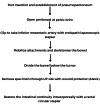Minimally Invasive Gastrointestinal Surgery: A Review
- PMID: 38106769
- PMCID: PMC10724411
- DOI: 10.7759/cureus.48864
Minimally Invasive Gastrointestinal Surgery: A Review
Abstract
Minimally invasive surgery uses several procedures with fewer side effects (bleeding, infections, etc.), a shorter hospital stay, and less discomfort following minimally invasive surgery. Laparoscopy was one of the first forms of minimally invasive surgery. It involves doing surgery while using tiny cameras through one or more small incisions, surgical tools along with tubes. Robotic surgery is another kind of minimally invasive procedure. Along with supporting accurate, flexible, and regulated surgical procedures, it provides the physician with a three-dimensional, enlarged view of the operative site. Minimally invasive surgery continues to advance, making it an advantage for patients with a variety of illnesses. Nowadays, many surgeons prefer it to traditional surgery, which frequently necessitates a longer hospital stay and requires larger incisions. Since then, numerous surgical specialties have greatly increased their use of minimally invasive surgery. A minimally invasive procedure is preferred for the majority of patients who require gastrointestinal surgery. Minimally invasive gastrointestinal procedures are just as successful as open procedures and, in some situations, may result in more effective outcomes. While recovery from open surgeries frequently takes five to ten days in the hospital, minimally invasive surgeries are less painful for patients and hasten recovery. It is safe from the perspective of the patient and has a lower postoperative mortality rate. This procedure involves a learning curve among surgeons.
Keywords: colorectal; gi surgery; minimally invasive laparoscopy; pancreas; small bowel.
Copyright © 2023, Singh et al.
Conflict of interest statement
The authors have declared that no competing interests exist.
Figures
References
-
- Gastrointestinal robot-assisted surgery. A current perspective. Lunca S, Bouras G, Stanescu AC. http://pubmed.ncbi.nlm.nih.gov/16400356/ Rom J Gastroenterol. 2005;14:385–391. - PubMed
-
- A surgeon robot prostatectomy—a laboratory evaluation. Davies B, Hibberd R, Coptcoat M, et al. J Med Eng Technol. 2009;13:273–277. - PubMed
-
- Davies B, Hibberd R, Timoney A, et al. Proc Inst Mech Eng C. Vol. 205. W S Ng; 1991. The development of a surgeon robot for prostatectomies; pp. 35–38. - PubMed
-
- Esophagectomy for esophageal disruption. Orringer M, Stirling M. Ann Thorac Surg. 1990;49 :35–42. - PubMed
Publication types
LinkOut - more resources
Full Text Sources


